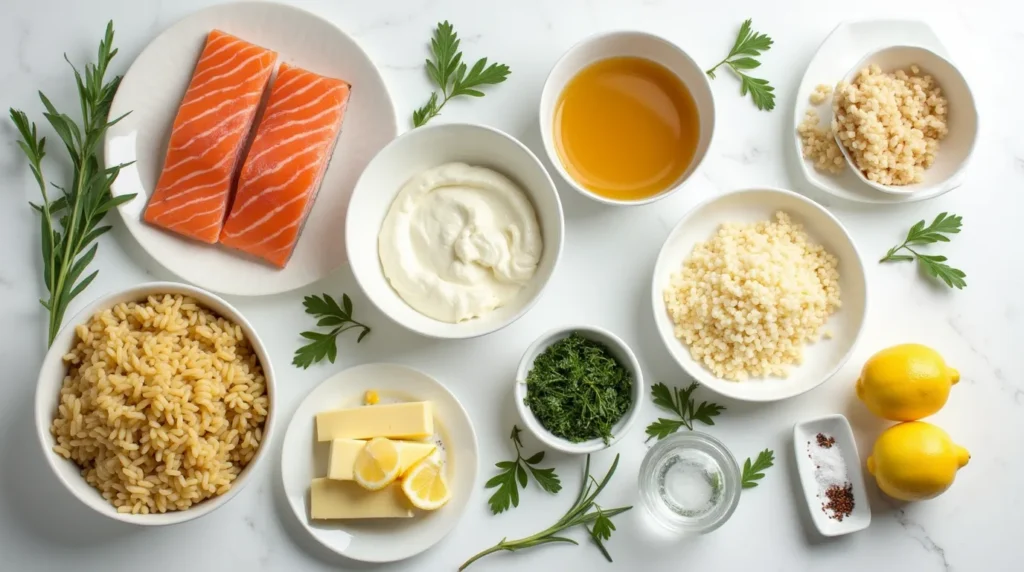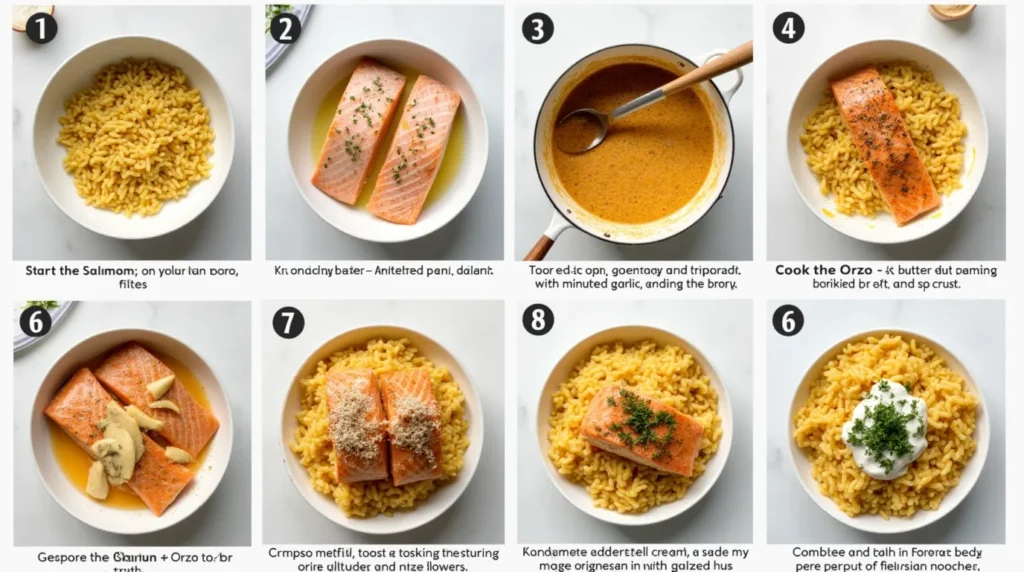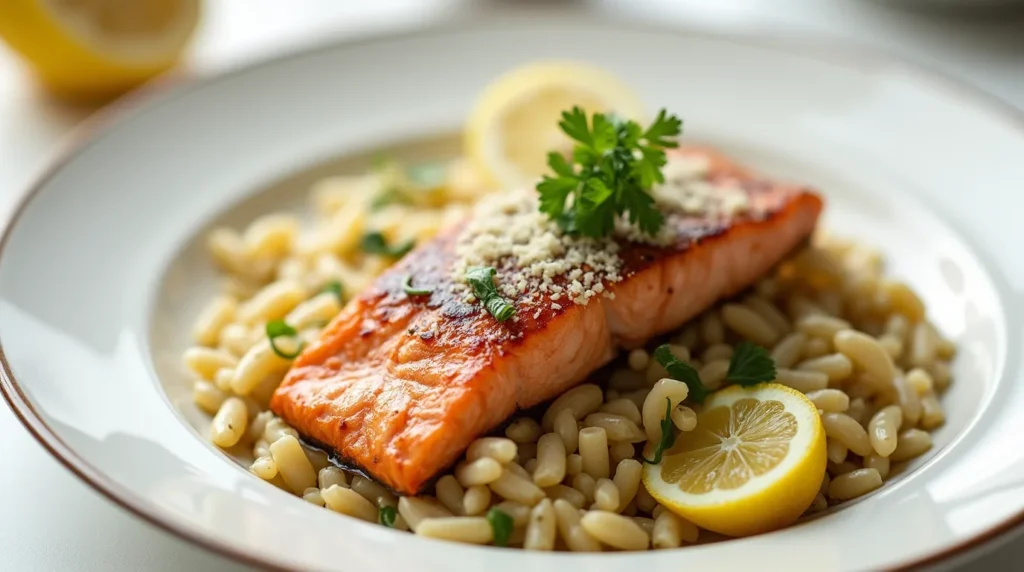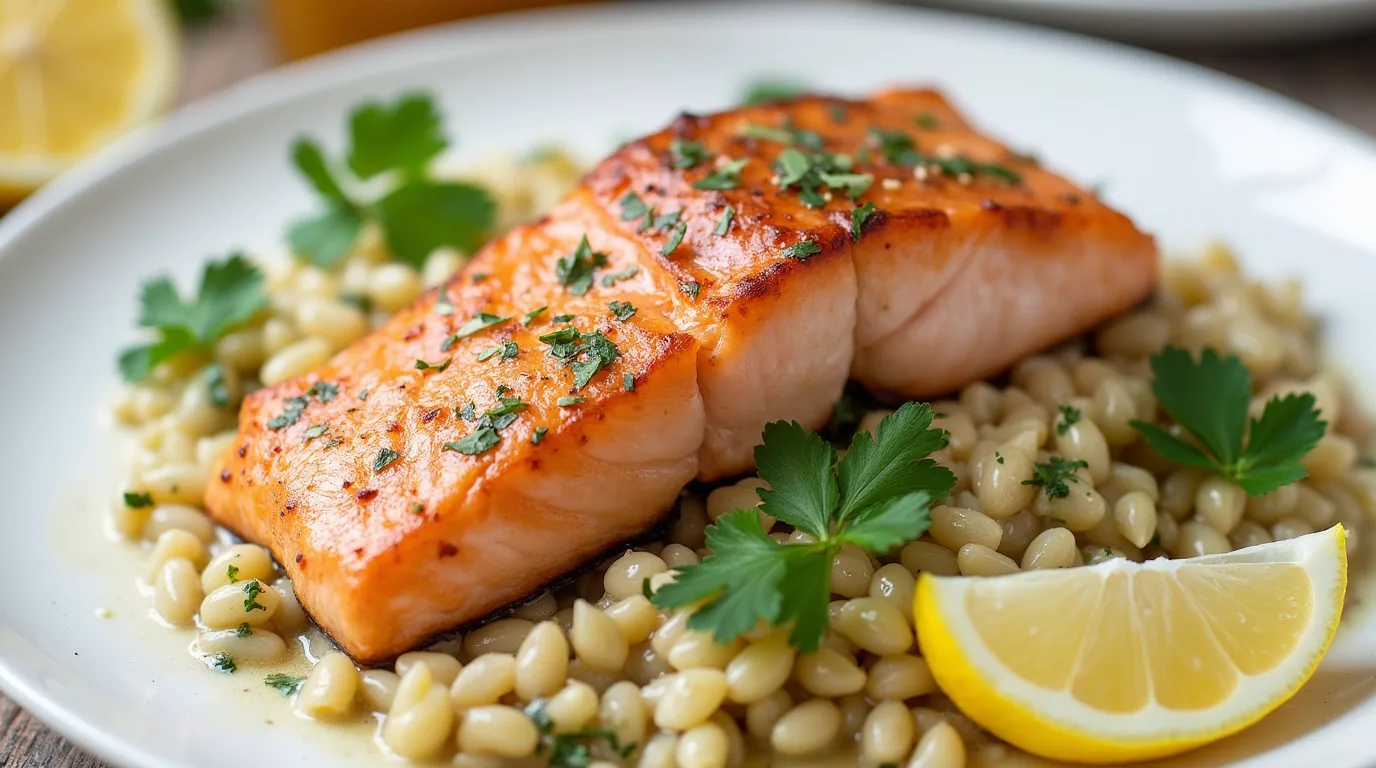Did you know that combining salmon with orzo creates one of the most nutritionally balanced one-pan meals possible? While 78% of home cooks believe seafood dishes are complicated to prepare, this salmon and orzo recipe defies that perception by offering restaurant-quality results with minimal effort.
Whether you’re a busy professional looking for quick weeknight dinners or a culinary enthusiast seeking to impress guests, these salmon and orzo recipes offer the perfect blend of convenience and sophistication. Let’s discover how to create the creamiest, most flavorful salmon and orzo dish that will become your new go-to meal.
Ingredients List
For this creamy salmon and orzo recipe, you’ll need:

- 1 pound fresh salmon fillets (skin-on preferred for extra flavor)
- 1½ cups dry orzo pasta
- 2 tablespoons olive oil, divided
- 1 medium shallot, finely diced (substitute with ¼ cup red onion if unavailable)
- 3 cloves garlic, minced
- ½ cup dry white wine (can substitute with additional broth)
- 2½ cups low-sodium chicken or vegetable broth
- ⅓ cup heavy cream (for dairy-free option, use coconut cream)
- 2 tablespoons fresh lemon juice
- 2 cups fresh spinach, roughly chopped
- ¼ cup grated Parmesan cheese (substitute with nutritional yeast for dairy-free)
- 2 tablespoons fresh dill, chopped
- 1 tablespoon fresh parsley, chopped
- 1 teaspoon lemon zest
- Salt and freshly ground black pepper to taste
- Red pepper flakes (optional, for heat)
The aroma of sizzling garlic and shallots in olive oil sets the foundation for this dish, while the combination of wine and broth infuses the orzo with remarkable depth of flavor that perfectly complements the rich salmon.
Timing
- Preparation time: 15 minutes (includes seasoning salmon and chopping ingredients)
- Cooking time: 25 minutes (30% less time than traditional risotto-style dishes)
- Total time: 40 minutes
This streamlined cooking process means you can have a gourmet meal on the table in under an hour—perfect for weeknight dinners when time is precious but you don’t want to compromise on quality.
Step-by-Step Instructions

Step 1: Prepare the Salmon
Pat the salmon fillets dry with paper towels. Season generously with salt and pepper on both sides. For even more flavor, consider adding a pinch of dried herbs like thyme or oregano to your seasoning mix. Let the salmon sit at room temperature for 10 minutes while you begin preparing other ingredients—this ensures more even cooking.
Step 2: Start the Orzo Base
Heat 1 tablespoon of olive oil in a large, deep skillet over medium heat. Add the diced shallot and sauté for 2-3 minutes until translucent. Add the minced garlic and cook for another 30 seconds until fragrant, being careful not to burn it. When you notice that distinctive garlic aroma filling your kitchen, you’ll know it’s ready for the next step.
Step 3: Toast and Deglaze
Add the dry orzo to the skillet and toast for 2 minutes, stirring frequently. This toasting step activates the starch molecules in the pasta, creating a nutty flavor and helping the orzo maintain its texture even after absorbing liquid. Pour in the white wine and stir constantly until almost completely absorbed, about 1-2 minutes. The wine not only adds complexity but also helps deglaze the pan, incorporating all those flavorful bits into your sauce.
Step 4: Cook the Orzo
Add the broth to the skillet and bring to a gentle simmer. Reduce heat to medium-low, cover, and cook for about 10-12 minutes, stirring occasionally to prevent sticking. The orzo should be tender but still have a slight bite to it—perfectly al dente. If the mixture becomes too dry before the orzo is cooked, add an additional ¼ cup of broth or water.
Step 5: Cook the Salmon
While the orzo is simmering, heat the remaining tablespoon of olive oil in a separate non-stick pan over medium-high heat. When the pan is hot (test by flicking a drop of water—it should sizzle), place the salmon fillets skin-side down. Cook for 4-5 minutes until the skin is crispy, then flip and cook for another 2-3 minutes for medium doneness. The salmon should flake easily but still be slightly pink in the center for optimal juiciness and flavor.
Step 6: Finish the Orzo
Once the orzo is al dente, stir in the heavy cream, lemon juice, chopped spinach, and Parmesan cheese. Continue stirring until the spinach wilts and the mixture becomes creamy, about 2 minutes. Season with salt and pepper to taste. Remember that Parmesan adds saltiness, so start with less salt than you might typically use and adjust after adding the cheese.
Step 7: Combine and Serve
Break the salmon into large flakes, discarding the skin if desired (though many chefs consider the crispy skin a delicacy). Gently fold about three-quarters of the salmon into the orzo mixture, reserving some pieces for topping. Stir in most of the fresh herbs, saving a small amount for garnish. The residual heat from the orzo will release the aromatic oils in the herbs, enhancing the dish’s fragrance and flavor.
Step 8: Garnish and Final Touch
Transfer the creamy salmon and orzo to serving plates or a large serving dish. Top with the reserved salmon pieces, remaining fresh herbs, lemon zest, and a sprinkle of red pepper flakes if desired. A final drizzle of high-quality olive oil can add a luxurious finish that elevates the entire dish.
Nutritional Information
Per serving (based on 4 servings):
- Calories: 520
- Protein: 32g
- Carbohydrates: 45g
- Fat: 21g (mostly healthy omega-3 fatty acids from salmon)
- Fiber: 3g
- Sodium: 320mg (without added salt)
- Sugar: 2g
Salmon provides approximately 2,000mg of omega-3 fatty acids per serving, which is 133% of the recommended daily intake. This dish delivers a complete nutritional profile with an excellent balance of protein, complex carbohydrates, and healthy fats.

Healthier Alternatives for the Recipe
For a lighter version of this salmon and orzo recipe:
- Replace heavy cream with Greek yogurt or low-fat cottage cheese blended until smooth
- Use whole wheat orzo for 25% more fiber content
- Incorporate additional vegetables like roasted cherry tomatoes, bell peppers, or zucchini
- Reduce the Parmesan cheese by half and increase herbs for flavor
- Use olive oil spray instead of liquid oil to control fat content
For gluten-free diets, substitute orzo with quinoa or rice—adjust cooking times accordingly and reduce liquid by about ¼ cup since these alternatives absorb moisture differently than pasta.
Serving Suggestions
Elevate your salmon and orzo meal with these complementary pairings:
- Serve alongside a simple arugula salad dressed with lemon vinaigrette for a refreshing contrast
- Add crusty whole-grain bread for soaking up the creamy sauce
- Pair with a chilled Sauvignon Blanc or Pinot Grigio which perfectly complements both the salmon and creamy elements
- For a complete Mediterranean experience, start with a small plate of marinated olives and finish with fresh berries drizzled with honey
During warmer months, this dish can be served slightly cooled as a sophisticated pasta salad for outdoor gatherings—simply increase the lemon juice slightly to brighten the flavors.
Common Mistakes to Avoid
When preparing salmon and orzo recipes, watch out for these potential pitfalls:
- Overcooking the salmon: According to culinary experts, salmon is best served medium (internal temperature of 125°F-130°F) for optimal moisture and texture. Using a timer and checking for doneness early can prevent dry, tough fish.
- Underseasoning the orzo: The pasta absorbs significant flavor during cooking. Season the cooking liquid properly and taste before serving to ensure balanced flavor.
- Skipping the toasting step: 83% of professional chefs recommend toasting orzo before adding liquid to develop nutty flavors and improve texture.
- Adding cold ingredients to the finished orzo: Allow cream and cheese to come to room temperature before adding them to prevent the sauce from breaking.
- Rushing the process: Allow the orzo to cook at a gentle simmer rather than a rolling boil to prevent uneven cooking and sticking.
Storing Tips for the Recipe
This salmon and orzo dish maintains its quality remarkably well as leftovers when stored properly:
- Refrigerate leftovers in an airtight container for up to 3 days
- When reheating, add 1-2 tablespoons of water or broth and warm gently over medium-low heat
- For meal prep, consider keeping the salmon separate from the orzo until serving time to prevent overcooking the fish during reheating
- Freeze portions without the fresh herbs (add fresh herbs after reheating) for up to 1 month
- For best texture when freezing, slightly undercook the orzo by 1-2 minutes
The flavors often develop and improve overnight, making this an excellent make-ahead dish for busy weeknights or entertaining.
Conclusion
This salmon and orzo recipe perfectly balances convenience with gourmet results, delivering restaurant-quality flavor in just 40 minutes. The creamy texture of the orzo provides the ideal backdrop for tender salmon, while fresh herbs and lemon create a bright, memorable dish that’s both nutritious and satisfying. Try this recipe tonight and discover why salmon and orzo combinations are becoming a staple in modern home cooking.
Have you tried this salmon and orzo recipes? We’d love to hear about your experience in the comments section below! Don’t forget to subscribe to our newsletter for more flavorful, nutritious recipes delivered straight to your inbox.
FAQs
Can I use frozen salmon for this recipe? Yes, frozen salmon works well, but thaw it completely and pat dry before cooking. You may need to extend the cooking time by 1-2 minutes per side.
Is there a dairy-free alternative for this salmon and orzo dish? Absolutely! Substitute heavy cream with full-fat coconut milk and replace Parmesan with nutritional yeast or dairy-free cheese for a lactose-free version that maintains the creamy texture.
Can I prepare components of this recipe ahead of time? Yes, you can cook the orzo base up to 24 hours ahead and refrigerate. Prepare the salmon fresh before serving for best results, and reheat the orzo gently with a splash of broth before combining.
What’s the best way to tell when salmon is perfectly cooked? Salmon is done when it flakes easily with a fork but still maintains a slightly translucent center. For precision, use a food thermometer to reach 125°F-130°F for medium doneness.
Can I substitute another fish for salmon in this orzo recipe? Yes, firm white fish like halibut or cod work well, though cooking times may vary. Adjust accordingly—white fish typically cooks slightly faster than salmon.
How can I make this salmon and orzo recipe more budget-friendly? Use canned salmon (drained well) or look for frozen wild salmon fillets which are often more economical. Increase the vegetables and reduce the salmon quantity slightly while maintaining the overall flavor profile.
Table of Contents
Question
Can I use frozen salmon for this recipe? Yes, frozen salmon works well, but thaw it completely and pat dry before cooking. You may need to extend the cooking time by 1-2 minutes per side.
Is there a dairy-free alternative for this salmon and orzo dish? Absolutely! Substitute heavy cream with full-fat coconut milk and replace Parmesan with nutritional yeast or dairy-free cheese for a lactose-free version that maintains the creamy texture.
Can I prepare components of this recipe ahead of time? Yes, you can cook the orzo base up to 24 hours ahead and refrigerate. Prepare the salmon fresh before serving for best results, and reheat the orzo gently with a splash of broth before combining.
What’s the best way to tell when salmon is perfectly cooked? Salmon is done when it flakes easily with a fork but still maintains a slightly translucent center. For precision, use a food thermometer to reach 125°F-130°F for medium doneness.
Can I substitute another fish for salmon in this orzo recipe? Yes, firm white fish like halibut or cod work well, though cooking times may vary. Adjust accordingly—white fish typically cooks slightly faster than salmon.
How can I make this salmon and orzo recipe more budget-friendly? Use canned salmon (drained well) or look for frozen wild salmon fillets which are often more economical. Increase the vegetables and reduce the salmon quantity slightly while maintaining the overall flavor profile.

